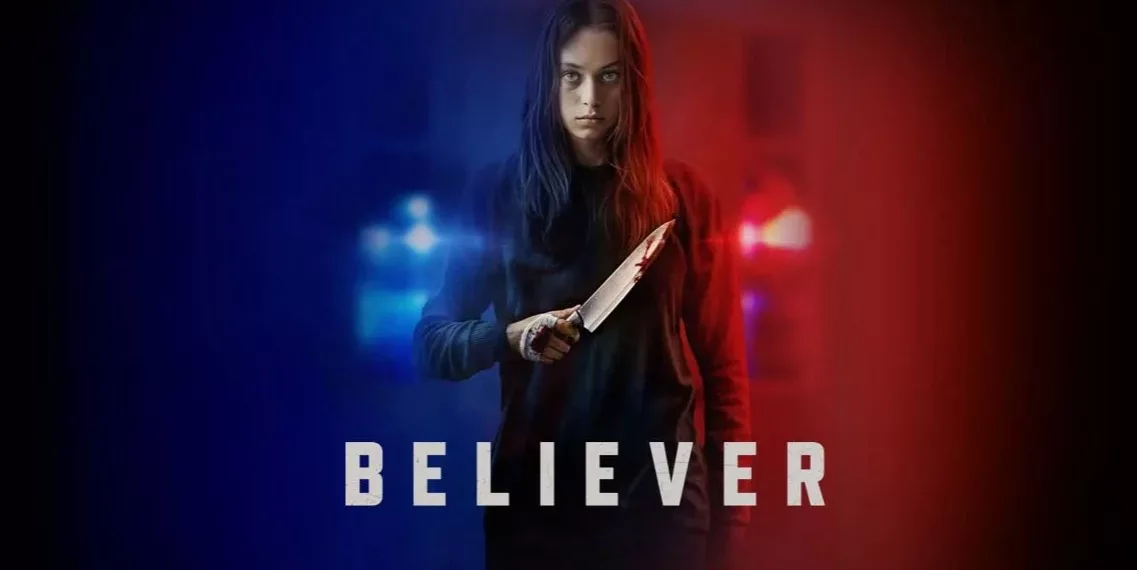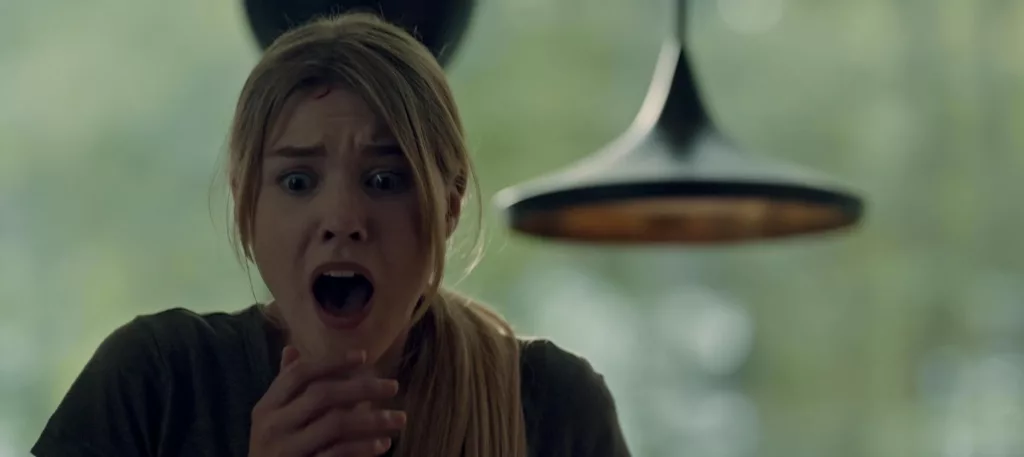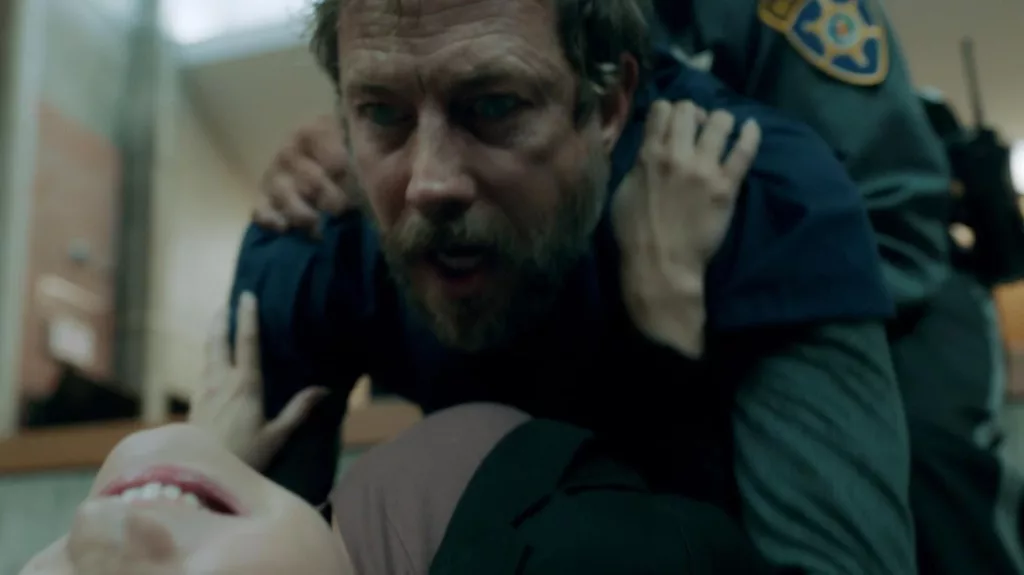Young writer Kate’s new project promised to be intriguing—researching an enigmatic cult leader who convinced dozens of followers to commit murder. But her investigation takes a shocking turn when the charismatic criminal attacks Kate at his own trial, leaving her without memory of the crucial encounter. What dark secrets did he impart in her ear before meeting a violent end?
Kate’s search for answers after the assault leads her to stay with her estranged sister Michelle and family. Yet strange events at the remote house suggest unseen forces meddling in their lives. Perplexing visions and unexplained behaviors bring more questions than solutions, deepening the mystery. Played compellingly by Ella Ballentine, Kate grows increasingly uncertain what is real as her grip on reality starts slipping.
Director Sheldon Wilson weaves a multilayered saga exploring the nature of influence, recollection, and sanity. Alongside Ella, Kris Holden-Ried instills cult leader Marshall Grayson with a chilling charisma, even in his limited appearances. Guiding viewers skillfully down Gardner’s twisting narrative path, Wilson leaves viewers guessing at the lurking menace until the climactic showdown.
Through compelling characters and an absorbing plot, Cult Conundrum delves into the psyche of those impacted by such criminal minds. Maintaining an aura of mystery throughout, Wilson keeps audiences enthralled in Kate’s pursuit of answers within an unsettling suspenseful thriller.
Intriguing Story, Uneven Pacing
The story opens with a shocking attack as writer Kate seeks to understand notorious cult leader Marshall Grayson. Left without memory of their strange encounter, she recuperates with estranged sister Michelle. Yet eerie events at the remote home soon raise suspicions of supernatural forces.
I found the setup quite compelling, pulling viewers into the mystery of Grayson’s message and his possible lingering influence. Ballentine and Smith also sold the complex sisterly dynamic undergoing new strains. Their fraught history added nuanced layers.
However, momentum slowed as bizarre visions and visions left more puzzlement than payoff. Twists seemingly led nowhere or contradicted prior information. While I admired attempts to challenge expectations, it sometimes muddled understanding. Key reveals remained elusively vague.
The cult backstory held fascination but received bare elaboration. I wanted richer exploration of how Grayson warped minds and what beliefs drove horrific crimes. Yet diving deeper risked plot holes or simplicism. A delicate balance seemed just out of reach.
By the abrupt end, slow sections disappointed where tension once thrilled. Ambiguous resolution fell short of satisfying, leaving some imbalance between intricacy and coherence. Could tightening pacing and sharpening logical consistency elevate an already solid feature?
Overall, Believer laid great groundwork for intrigue that an uneven structure partially hindered. With refinement, it might have totally captivated. As is, the stellar performances and chilling premise still make it worth considering.
Complex Characters at the Core
At the heart of Believer lay its compelling characters and the actors embodying them. Kate stood as a nuanced lead role, her fraying mental state portrayed subtly through Ballentine’s interior performance. Was she a deceiver or deceived agent or acted upon? Ballentine instilled her character with an unsettled aura worthy of empathy yet skepticism.
Holden-Ried also left an impactful mark despite Grayson’s minimal screentime. An unnerving charisma surrounded the enigmatic cultist, ensuring his nefarious influence felt long after exits. Whether directly seen or alluded to, he burrowed ominously under the viewers’ skin.
The fraught bond between Kate and sister Michelle came to the fore; their interaction ringed with hurt but also signs of hoped-for healing. Smith tapped into complex layers within Michelle—protector yet plagued by sisterly doubts. Their dynamic brought nuanced emotional stakes.
Supporting players like Ella, David, and Detective Brener proved more than mere props, breathing life into their characters. Each left impressions aligning with or challenging presumptions, multifaceted performances all around.
Cast talents sparked investiture in even the least-seen figures populating Believer’s shadows. Their nuanced work anchored intriguing arcs that, while not all perfectly paced, remained compelling thanks to relatable characters at the core.
Atmosphere and Artistry
Director Sheldon Wilson wove an enveloping shroud of unease throughout Believer. Spooky backwoods settings and shadowy interiors heightened a pervasive sense of lurking dread. Lingering shots maintained tension as murky details emerged by twilight gleam.
Wilson ushered viewers skillfully through this grim fairy tale. Scenes drew out chilled sensations yet flowed at a compulsive clip. Smooth camera pans and zooms intensified claustrophobic feels inside Kate’s unraveling psyche.
Color palette and lighting design also left impressions. Dim hues molded an air of bleak isolation. Flashlights and flickers suggested malign presences beyond view. Simple flourishes like these substantiated menaces where less was explicitly shown.
Musical cues complemented this unsettling ambiance, enhancing ambiguities instead of clarifying them. Melodies drifted as ominously as nightfall, beckoning audiences deeper into uncertain wonderings.
Standout locales included the rural home undergoing eerie change and surrounding woodland shrouds concealing lurking mysteries. Cinematography brought visual allure to these tangible spaces within intangible psychological edges.
In the end, director Wilson ferried viewers skillfully through his oblique thriller via atmospheric immersion. Subtle techniques gripped audiences as insight by insight unraveled Believer’s hypnotic spell.
Perspectives and Possibilities
Sheldon Wilson imbued Believer with potent thematic undercurrents. His exploration of cult dynamics and their impact resonated long after credits rolled.
Dominating the narrative was the insidious nature of mind control and reality manipulation. Grayson’s twisted ability to warp perception left audiences questioning the trustworthiness of even our own recollections. Wilson stirred such disquiet yet avoided simple answers.
Familial bonds undergoing trial in tragedy’s aftermath comprised another thread. Kate and Michelle’s tattered sisterhood emerged as one relationship, navigating blurred lines. Their depictions struck multi-faceted emotional chords.
While cult psychology drove the core mystery, Believer refrained from definitive messaging. Wilson invited multiple interpretations of humanity’s susceptibility to influence and memory’s fallibility. Do we fully grasp the motives behind our own acts?
Some may detect socio-political overlays regarding leadership abuse and mass movements. Ultimately, Wilson prioritized questions over responses. Believer endures by stirring contemplation on control mechanisms rather than accusations.
Subtly woven, these motifs enriched a chilling story without a single conclusive read. Ambiguities personified life’s complexities, leaving perspectives as abundant as viewers themselves. All in all, a testament to cinema’s potential for probing life’s dilemmas.
Resonating Reflections
Sheldon Wilson’s Believer invoked other compelling cult-centric films while carving its own unsettling identity. Similarities existed, yet differences left their own impacts.
Comparisons inevitably arose to thrillers like Martha Marcy May Marlene and disturbing documentaries exploring real groups. Believer echoed their nuanced scrutiny of mind control yet skewed darker in tone.
Where others delved deep into particular cult infrastructures, Wilson instead fixated on one leader’s twisting of two sisters’ lives. Cryptic mysteries unfurled in visceral close-ups rather than broad organizational exposes.
Effectively haunting scenes were reminiscent of slower-burn undercurrents in The Invitation yet pulsated with an unhinged vitality all its own. Wilson prioritized intimate turmoil over grand schemes yet stirred chills accordingly.
Areas for potential improvement involved tightening sporadic pacing gaps and fleshing out cult logic holes. Yet performers’ authentically erratic descents anchored even ambivalent passages.
In the end, Morrison’s film refused simple definitions while conveying culticated themes through twisted family bonds. Ambiguities stirred interpretation where other works provided answers. Its unsettling resonances continue demanding reflection.
Final Thoughts
Believer proved a complex tale, wielding creative flair yet uneven execution at times. Sheldon Wilson granted cinephiles chilling characters navigating blurred realities with nuanced performances at the helm.
When maintaining suspense’s unsettled grip, disturbing cult dynamics emerged effectively explored. Visual panache transported viewers into scenes marred by unseen threats. Yet occasional pacing lagged where momentum once intrigued.
Overall, however, Believer offered an uncommonly intriguing nightmare meriting appreciation. Cult aficionados and psychological thriller enthusiasts especially will find much to ponder within its perplexing and haunting design.
Wilson forged an unsettling experience indeed, albeit one that may test patience for some viewers. With refinement addressing flow irregularities, Believer showed promise as a compelling bone-chiller delving beneath society’s surface.
I thank you for reviewing these perspectives on the film. While imperfect, Believer epitomized cinema’s capacity for social commentary through twisted fare meant to disturb and linger long after closing credits. Its challenging content and bleak beauty keep discussion alive.
The Review
Believer
Believer shows flashes of brilliance as a chilling examination of cult dynamics and fractured reality, buoyed by nuanced performances. However, some uneven pacing and narrative gaps curb its overall impact. With a tighter edit maximizing intrigue, it could have been truly compelling. Nevertheless, director Sheldon Wilson crafts an unsettling atmosphere that may resonate long after for thoughtful genre fans.
PROS
- Unsettling atmosphere and aesthetic successfully pull viewers into the film's world of blurred reality
- Complex characters and performances, especially from Ella Ballentine in the lead role
- Thought-provoking examination of cult dynamics and their psychological impacts
CONS
- Narrative pacing is uneven at times, with some gaps impeding momentum
- Backstory elements around the cult leader could be more fully developed
- Ambiguous story elements may frustrate those seeking tighter resolution





















































